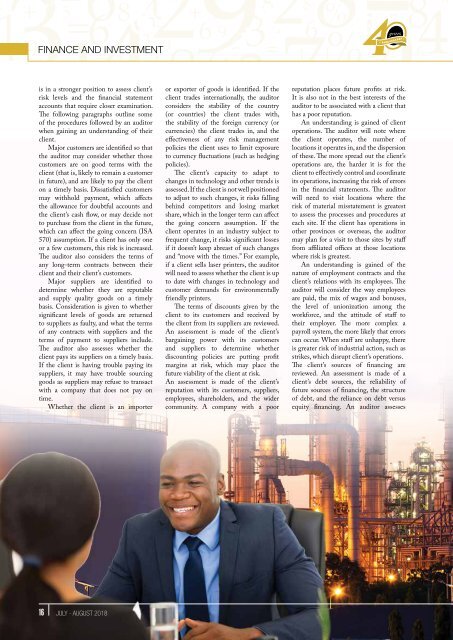The-Accountant-July-Aug-2018
Create successful ePaper yourself
Turn your PDF publications into a flip-book with our unique Google optimized e-Paper software.
Finance and investment<br />
is in a stronger position to assess client’s<br />
risk levels and the financial statement<br />
accounts that require closer examination.<br />
<strong>The</strong> following paragraphs outline some<br />
of the procedures followed by an auditor<br />
when gaining an understanding of their<br />
client.<br />
Major customers are identified so that<br />
the auditor may consider whether those<br />
customers are on good terms with the<br />
client (that is, likely to remain a customer<br />
in future), and are likely to pay the client<br />
on a timely basis. Dissatisfied customers<br />
may withhold payment, which affects<br />
the allowance for doubtful accounts and<br />
the client’s cash flow, or may decide not<br />
to purchase from the client in the future,<br />
which can affect the going concern (ISA<br />
570) assumption. If a client has only one<br />
or a few customers, this risk is increased.<br />
<strong>The</strong> auditor also considers the terms of<br />
any long-term contracts between their<br />
client and their client’s customers.<br />
Major suppliers are identified to<br />
determine whether they are reputable<br />
and supply quality goods on a timely<br />
basis. Consideration is given to whether<br />
significant levels of goods are returned<br />
to suppliers as faulty, and what the terms<br />
of any contracts with suppliers and the<br />
terms of payment to suppliers include.<br />
<strong>The</strong> auditor also assesses whether the<br />
client pays its suppliers on a timely basis.<br />
If the client is having trouble paying its<br />
suppliers, it may have trouble sourcing<br />
goods as suppliers may refuse to transact<br />
with a company that does not pay on<br />
time.<br />
Whether the client is an importer<br />
or exporter of goods is identified. If the<br />
client trades internationally, the auditor<br />
considers the stability of the country<br />
(or countries) the client trades with,<br />
the stability of the foreign currency (or<br />
currencies) the client trades in, and the<br />
effectiveness of any risk management<br />
policies the client uses to limit exposure<br />
to currency fluctuations (such as hedging<br />
policies).<br />
<strong>The</strong> client’s capacity to adapt to<br />
changes in technology and other trends is<br />
assessed. If the client is not well positioned<br />
to adjust to such changes, it risks falling<br />
behind competitors and losing market<br />
share, which in the longer term can affect<br />
the going concern assumption. If the<br />
client operates in an industry subject to<br />
frequent change, it risks significant losses<br />
if it doesn’t keep abreast of such changes<br />
and “move with the times.” For example,<br />
if a client sells laser printers, the auditor<br />
will need to assess whether the client is up<br />
to date with changes in technology and<br />
customer demands for environmentally<br />
friendly printers.<br />
<strong>The</strong> terms of discounts given by the<br />
client to its customers and received by<br />
the client from its suppliers are reviewed.<br />
An assessment is made of the client’s<br />
bargaining power with its customers<br />
and suppliers to determine whether<br />
discounting policies are putting profit<br />
margins at risk, which may place the<br />
future viability of the client at risk.<br />
An assessment is made of the client’s<br />
reputation with its customers, suppliers,<br />
employees, shareholders, and the wider<br />
community. A company with a poor<br />
reputation places future profits at risk.<br />
It is also not in the best interests of the<br />
auditor to be associated with a client that<br />
has a poor reputation.<br />
An understanding is gained of client<br />
operations. <strong>The</strong> auditor will note where<br />
the client operates, the number of<br />
locations it operates in, and the dispersion<br />
of these. <strong>The</strong> more spread out the client’s<br />
operations are, the harder it is for the<br />
client to effectively control and coordinate<br />
its operations, increasing the risk of errors<br />
in the financial statements. <strong>The</strong> auditor<br />
will need to visit locations where the<br />
risk of material misstatement is greatest<br />
to assess the processes and procedures at<br />
each site. If the client has operations in<br />
other provinces or overseas, the auditor<br />
may plan for a visit to those sites by staff<br />
from affiliated offices at those locations<br />
where risk is greatest.<br />
An understanding is gained of the<br />
nature of employment contracts and the<br />
client’s relations with its employees. <strong>The</strong><br />
auditor will consider the way employees<br />
are paid, the mix of wages and bonuses,<br />
the level of unionization among the<br />
workforce, and the attitude of staff to<br />
their employer. <strong>The</strong> more complex a<br />
payroll system, the more likely that errors<br />
can occur. When staff are unhappy, there<br />
is greater risk of industrial action, such as<br />
strikes, which disrupt client’s operations.<br />
<strong>The</strong> client’s sources of financing are<br />
reviewed. An assessment is made of a<br />
client’s debt sources, the reliability of<br />
future sources of financing, the structure<br />
of debt, and the reliance on debt versus<br />
equity financing. An auditor assesses<br />
16 JULY - AUGUST <strong>2018</strong>

















